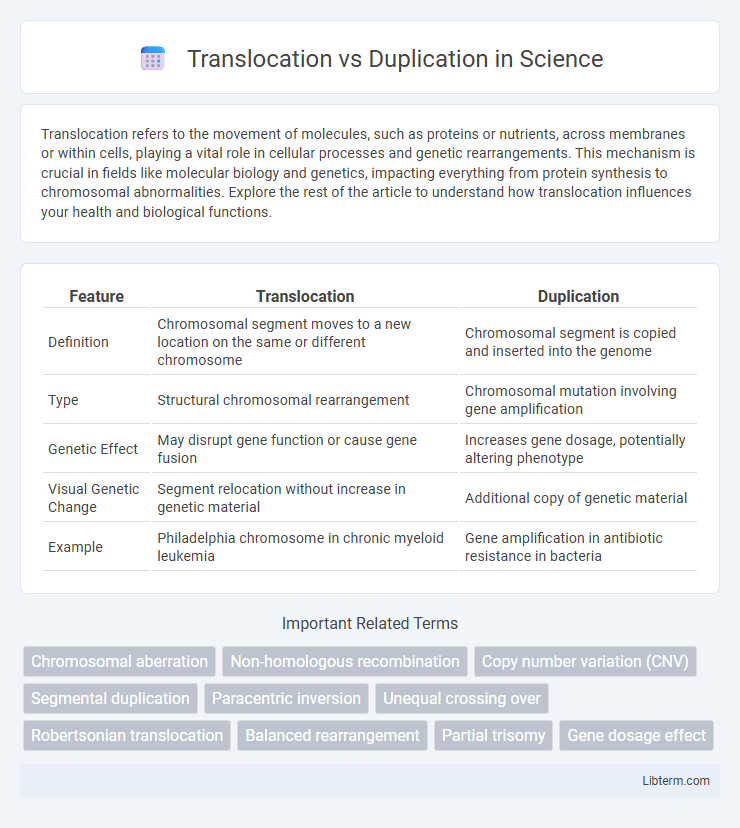Translocation refers to the movement of molecules, such as proteins or nutrients, across membranes or within cells, playing a vital role in cellular processes and genetic rearrangements. This mechanism is crucial in fields like molecular biology and genetics, impacting everything from protein synthesis to chromosomal abnormalities. Explore the rest of the article to understand how translocation influences your health and biological functions.
Table of Comparison
| Feature | Translocation | Duplication |
|---|---|---|
| Definition | Chromosomal segment moves to a new location on the same or different chromosome | Chromosomal segment is copied and inserted into the genome |
| Type | Structural chromosomal rearrangement | Chromosomal mutation involving gene amplification |
| Genetic Effect | May disrupt gene function or cause gene fusion | Increases gene dosage, potentially altering phenotype |
| Visual Genetic Change | Segment relocation without increase in genetic material | Additional copy of genetic material |
| Example | Philadelphia chromosome in chronic myeloid leukemia | Gene amplification in antibiotic resistance in bacteria |
Understanding Chromosomal Mutations
Translocation involves the rearrangement of chromosome segments between nonhomologous chromosomes, often disrupting gene function or regulation, while duplication refers to the repetition of a chromosome segment, leading to multiple copies of particular genes. Both chromosomal mutations can result in genetic disorders or contribute to evolution by altering gene dosage and genomic architecture. Understanding these mutations is essential for diagnosing diseases like cancer and developmental syndromes caused by abnormal chromosomal structures.
Defining Translocation: Types and Mechanisms
Translocation is a chromosomal abnormality involving the rearrangement of segments between non-homologous chromosomes, classified primarily into reciprocal and Robertsonian types. Reciprocal translocations occur when segments from two different chromosomes are exchanged without genetic loss, while Robertsonian translocations involve the fusion of two acrocentric chromosomes at their centromeres, resulting in one large chromosome. The mechanisms underlying translocation include non-homologous end joining during DNA repair and errors in meiosis, which can disrupt gene function and lead to genetic disorders or cancer.
Exploring Duplication: Forms and Processes
Duplication occurs when segments of DNA are copied and inserted into the genome, resulting in multiple copies of the same genetic material that can lead to gene redundancy and evolutionary innovation. Forms of duplication include tandem duplication, where copies lie adjacent on the same chromosome, and segmental duplication, involving larger DNA blocks that may occur on different chromosomes. This process is mediated by mechanisms such as unequal crossing over during meiosis, replication slippage, and retrotransposition, significantly contributing to genome expansion and functional diversification.
Key Differences Between Translocation and Duplication
Translocation involves the rearrangement of chromosome segments between nonhomologous chromosomes, while duplication results in the repetition of a chromosome segment within the same chromosome. Translocations can be reciprocal or nonreciprocal, often leading to gene disruption or altered gene dosage, whereas duplications increase gene copy number, potentially enhancing gene expression or causing genetic imbalance. The key difference lies in translocation altering chromosome structure and position without increasing genetic material, whereas duplication increases the amount of genetic content by copying chromosomal segments.
Causes of Translocation and Duplication
Translocation occurs due to the breakage of chromosomes followed by the improper rejoining of fragments between non-homologous chromosomes, often caused by radiation, chemical exposure, or errors during meiosis. Duplication results from unequal crossing over or replication errors during DNA synthesis, leading to the presence of extra copies of a chromosome segment. Both structural rearrangements significantly impact gene dosage and genome stability, contributing to genetic disorders and evolutionary variations.
Genetic Disorders Linked to Translocation
Translocation involves the rearrangement of chromosome segments, often leading to genetic disorders such as chronic myeloid leukemia and Down syndrome due to improper chromosome segregation. Duplication results in extra copies of chromosome segments, potentially causing developmental delays and conditions like Charcot-Marie-Tooth disease type 1A. Chromosomal translocations, especially reciprocal and Robertsonian types, disrupt gene function and expression, significantly contributing to disease pathogenesis.
Health Impacts of Chromosomal Duplication
Chromosomal duplication results in extra copies of a chromosome segment, leading to gene dosage imbalances that may disrupt normal cellular function and development. Health impacts of chromosomal duplication include congenital abnormalities, developmental delays, and increased risk for certain genetic disorders such as Charcot-Marie-Tooth disease type 1A. Unlike translocations, which involve rearrangement of chromosome segments without gain or loss of genetic material, duplications often cause more severe phenotypic consequences due to additional genetic content.
Diagnostic Techniques for Chromosomal Abnormalities
Fluorescence in situ hybridization (FISH) provides precise localization of translocations by using fluorescent probes targeting specific chromosomal regions, enabling the detection of balanced and unbalanced rearrangements. Array comparative genomic hybridization (aCGH) excels at identifying duplications by detecting copy number variations across the genome with high resolution but cannot reliably detect balanced translocations. Next-generation sequencing (NGS) techniques offer comprehensive analysis by pinpointing breakpoints at the nucleotide level, facilitating the diagnosis of both translocations and duplications in clinical cytogenetics.
Implications for Inheritance and Evolution
Translocation involves the rearrangement of chromosome segments between non-homologous chromosomes, often disrupting gene function and affecting inheritance by creating novel gene combinations or causing fertility issues due to improper segregation. Duplication leads to extra copies of chromosome segments, increasing gene dosage and providing raw material for evolutionary innovation by enabling functional divergence and adaptation. Both chromosomal abnormalities influence genetic diversity and evolutionary dynamics but through distinct mechanisms impacting genome structure and inheritance patterns.
Advances in Treatment and Genetic Counseling
Advances in treatment for translocation and duplication abnormalities now emphasize precise genomic analysis techniques such as array CGH and next-generation sequencing, enabling targeted therapeutic strategies and early intervention. Genetic counseling incorporates enhanced risk assessment models based on detailed chromosomal mapping, improving reproductive planning and personalized patient guidance. Integration of molecular diagnostics with counseling supports informed decision-making for affected families, reducing recurrence risk and optimizing clinical outcomes.
Translocation Infographic

 libterm.com
libterm.com